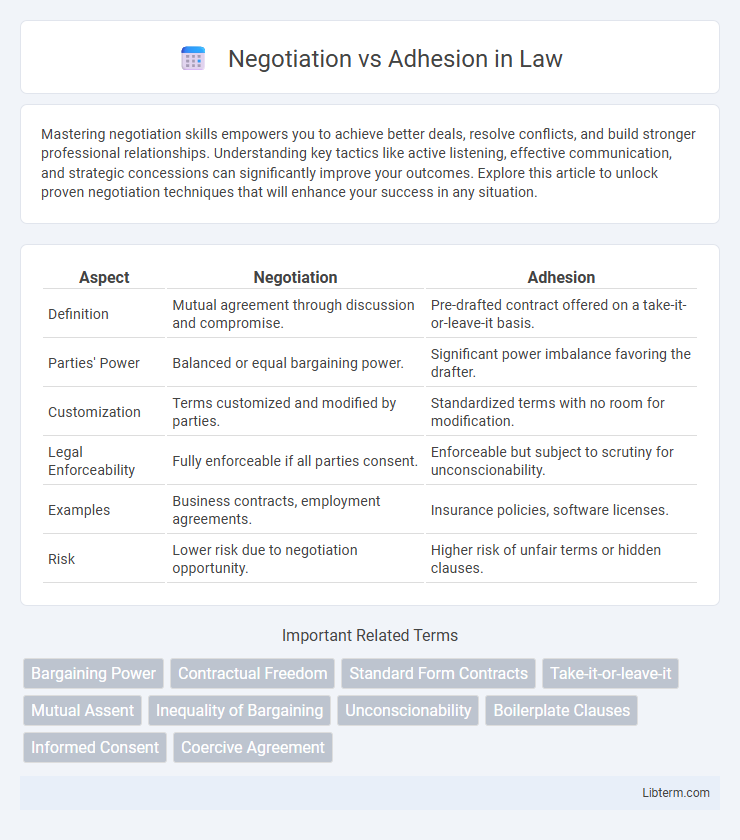Mastering negotiation skills empowers you to achieve better deals, resolve conflicts, and build stronger professional relationships. Understanding key tactics like active listening, effective communication, and strategic concessions can significantly improve your outcomes. Explore this article to unlock proven negotiation techniques that will enhance your success in any situation.
Table of Comparison
| Aspect | Negotiation | Adhesion |
|---|---|---|
| Definition | Mutual agreement through discussion and compromise. | Pre-drafted contract offered on a take-it-or-leave-it basis. |
| Parties' Power | Balanced or equal bargaining power. | Significant power imbalance favoring the drafter. |
| Customization | Terms customized and modified by parties. | Standardized terms with no room for modification. |
| Legal Enforceability | Fully enforceable if all parties consent. | Enforceable but subject to scrutiny for unconscionability. |
| Examples | Business contracts, employment agreements. | Insurance policies, software licenses. |
| Risk | Lower risk due to negotiation opportunity. | Higher risk of unfair terms or hidden clauses. |
Understanding Negotiation: Key Principles
Understanding negotiation involves recognizing it as a dynamic communication process where parties with differing interests engage to reach a mutually beneficial agreement. Key principles include preparation by gathering relevant information, active listening to understand counterpart's needs, and effective problem-solving to create value. Emphasizing collaboration over competition enhances trust and facilitates sustainable agreements in negotiation scenarios.
Defining Adhesion Contracts
Adhesion contracts are standardized agreements drafted by one party with stronger bargaining power, typically presented on a take-it-or-leave-it basis to the weaker party without room for negotiation. These contracts are common in consumer transactions, insurance policies, and service agreements, where the adhering party cannot alter terms but must accept them as is. Courts often scrutinize adhesion contracts for fairness and unconscionability, ensuring they do not exploit the weaker party's lack of choice or knowledge.
Core Differences Between Negotiation and Adhesion
Negotiation involves a mutual exchange where parties actively discuss terms to reach a tailored agreement, emphasizing equal bargaining power and consent. In contrast, adhesion contracts are standard-form agreements drafted by one party, offering non-negotiable terms that the other party must accept as-is, highlighting a lack of negotiation and often imbalanced power dynamics. The core difference lies in the presence or absence of negotiation, shaping the degree of flexibility, consent, and fairness in contract formation.
Legal Implications of Negotiated and Adhesion Agreements
Negotiated agreements involve parties actively discussing and modifying contract terms, resulting in mutual consent that strengthens enforceability and reduces claims of unfairness or duress. Adhesion agreements, typically standard-form contracts presented on a take-it-or-leave-it basis, raise legal concerns about unconscionability, lack of meaningful consent, and potential invalidation in courts due to imbalance of power. Courts scrutinize adhesion contracts more rigorously to protect weaker parties from unfair terms, especially in consumer and employment contexts.
Power Dynamics in Negotiated versus Adhesion Contracts
Negotiated contracts typically feature balanced power dynamics, allowing both parties to influence terms and reach mutual agreement through discussion and compromise. Adhesion contracts, often presented on a take-it-or-leave-it basis by the stronger party, reflect significant power imbalance, limiting the weaker party's ability to negotiate terms. This disparity in bargaining power impacts contract enforceability and the degree of fairness perceived in adhesion versus negotiated agreements.
Common Examples in Business and Consumer Law
Negotiation commonly occurs in business contracts such as mergers, supplier agreements, and employment contracts, where terms are mutually discussed and modified to suit both parties. Adhesion contracts are prevalent in consumer law, exemplified by software licenses, insurance policies, and standard form agreements where consumers must accept preset terms without modification. Understanding the distinction impacts dispute resolution and enforcement, as negotiated contracts imply mutual consent while adhesion contracts often involve take-it-or-leave-it conditions favoring the drafting party.
Advantages of Negotiated Contracts
Negotiated contracts offer the advantage of customized terms that reflect the specific needs and interests of all parties involved, enhancing mutual satisfaction and collaboration. They enable flexibility in addressing complex issues or unique circumstances, reducing ambiguities and potential disputes. Greater bargaining power fosters clearer communication and stronger long-term relationships between contracting parties.
Risks and Concerns in Adhesion Contracts
Adhesion contracts pose significant risks including limited negotiation power, which can lead to unfair terms heavily favoring the drafter. Consumers frequently encounter ambiguous language and unconscionable clauses, increasing vulnerability to exploitative practices. Judicial scrutiny often centers on the imbalance of bargaining power and the potential for hidden or oppressive contract provisions.
Protecting Your Rights in Adhesion Scenarios
In adhesion contract scenarios, protecting your rights requires a clear understanding that these non-negotiable agreements often favor the drafter, usually a business or institution. Unlike negotiated contracts where terms are mutually agreed upon, adhesion contracts present take-it-or-leave-it terms, making it crucial to scrutinize clauses for unfair or unconscionable conditions. Legal protections, such as doctrines preventing unequal bargaining power abuses and courts' willingness to void unconscionable terms, serve to safeguard individuals against potential exploitation in adhesion agreements.
Best Practices for Effective Contract Outcomes
Effective contract outcomes require understanding the distinctions between negotiation and adhesion contracts; negotiation involves mutual agreement with flexible terms, while adhesion contracts are pre-drafted by one party with little room for modification. Best practices include ensuring clear communication, thorough review of contract terms, and seeking legal advice to identify and address potential imbalances or unfair clauses in adhesion contracts. Employing transparent negotiation strategies and tailoring contract language to reflect both parties' interests enhances enforceability and mitigates risks associated with ambiguous or one-sided agreements.
Negotiation Infographic

 libterm.com
libterm.com